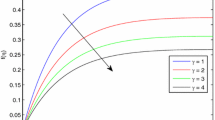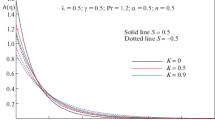Summary
The heat transfer from a stretching sheet to a micropolar fluid is analyzed using the theory of micropolar fluids formulated by Eringen. The governing equations for momentum, angular momentum and energy have been solved numerically. Numerical data for the friction factor and Nusselt number has been tabulated for a range of Prandtl numbers. Surface mass transfer rate and the power law constant for the wall temperature have considerable influence on the heat transfer mechanism.
Similar content being viewed by others
Abbreviations
- E c :
-
Eckert number
- f :
-
dimensionless velocity function
- g :
-
dimensionless microrotation
- G, N 1 :
-
dimensionless material parameters
- j :
-
microinertia per unit mass
- K :
-
material coefficient
- N :
-
angular velocity
- Nu :
-
Nusselt number
- Pr :
-
Prandtl number
- Re :
-
Reynolds number
- T :
-
temperature
- u :
-
surface velocity
- v :
-
velocity iny-direction
- U s :
-
surface velocity
- x :
-
distance along the surface
- y :
-
distance normal to the surface
- μ:
-
viscosity coefficient
- ϱ:
-
density of the fluid
- σ:
-
dimensionless temperature
- γ:
-
power law exponent
- ω:
-
conditions at the surface
- ∞:
-
conditions far away from the surface
References
Hoyt, J. W., Fabula, A. G.: The effect of additives on fluid friction. U.S. Naval Ordinance Test Station Report (1964).
Vogel, W. M., Patterson, A. M.: An experimental investigation of additives injected into the boundary layer of an underwater body. Pacific Naval Lab. of the Defense Res. Board of Canada, Report 64-2 (1964).
Eringen, A. C.: Theory of micropolar fluids. J. Math. Mech.16, 1 (1966).
Eringen, A. C.: Theory of thermomicrofluids. J. Math. Anal. Appl.38, 480 (1972).
Sakiadis, B. C.: Boundary layer behavior on continuous solid surface; the boundary layer on a continuous flat surface. Am. Inst. Chem. Engrs J.7, 221 (1961).
Soundalgekar, V. M., Takhar, H. S.: Boundary layer flow of a micropolar fluid on a continuous moving plate. Int. J. Engng Sci.21, 961 (1983).
Gorla, R. S. R., Ameri A.: Boundary layer flow of a micropolar fluid on a continuous moving cylinder. Acta Mech.53, 203 (1985).
Gorla, R. S. R.: Combined forced and free convection in the boundary layer flow of a micropolar fluid on a continuous moving vertical cylinder. Int. J. Engng Sci.27, 77 (1989).
Crane, L. J.: Heat transfer on continuous solid surfaces. J. Appl. Math. Phys.21, 645 (1970).
Gupta, P. S., Gupta, A. S.: Heat and mass transfer on a stretching sheet with suction and blowing. Can. J. Chem. Engng.55, 744 (1977).
Dutta, B. K., Roy, P., Gupta, A. S.: Heat transfer on stretching sheet. Int. Commun. Heat Mass Transfer12, 89 (1985).
Author information
Authors and Affiliations
Rights and permissions
About this article
Cite this article
Hassanien, I.A., Gorla, R.S.R. Heat transfer to a micropolar fluid from a non-isothermal stretching sheet with suction and blowing. Acta Mechanica 84, 191–199 (1990). https://doi.org/10.1007/BF01176097
Received:
Revised:
Issue Date:
DOI: https://doi.org/10.1007/BF01176097




